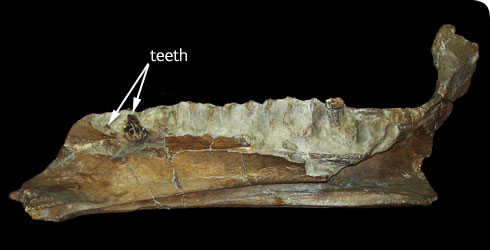Taxonomy
Identification
Kukufeldia tilgatensis is an iguanodontian ornithopod dinosaur - a member of the same dinosaur group as Iguanodon, Mantellisaurus and Camptosaurus.
Its identification is based on a single right lower jaw (NHMUK 28660) that contains several unerupted teeth.
In general, the jaw and teeth are very similar to those of its close relatives, such as Iguanodon. However, Kukufeldia possesses a row of small holes (termed ‘foramina’) that is positioned just behind the front end of the lower jaw.
These holes were channels for blood vessels and nerves and formed a line that ran parallel to the tip of the jaw.
No other ornithopod dinosaur possesses this unique row of additional foramina on the jaw and this allowed the specimen to be recognised as a new species in 2010 (McDonald et al 2010).
Other features of the jaw, including the shape of the tooth sockets and the sites of attachment for the jaw muscles also differ from those seen in other closely related dinosaurs.
Morphology
Although known from fragmentary remains, the teeth and lower jaw of Kukufeldia indicate that it was an animal that would have been very similar in appearance to better-known Cretaceous ornithopods like Iguanodon and Mantellisaurus.
Like its better known relatives, Kukufeldia was probably a bipedal animal, with strong muscular hindlimbs and relatively small forelimbs that would have been used for:
- foraging
- defence
- occasionally walking on all fours
The head had a long, deep snout and the jaws were lined with grinding teeth and tipped with a horny beak.
It is possible that Kukufeldia possessed a thumb-spike, like its relatives.
